Virtual Reality: Ethical Concerns, Challenges, and Benefits Essay
VerifiedAdded on 2022/09/08
|8
|1475
|25
Essay
AI Summary
This essay delves into the world of virtual reality (VR), examining its historical development, diverse applications, and societal impact. It discusses the evolution of VR, from its early inception to its current widespread use across various industries, including manufacturing, education, and gaming. The essay explores both the advantages and disadvantages of VR, highlighting its potential to create simulated environments, improve skills, and address business challenges. However, it also addresses the ethical concerns related to privacy, virtual crimes, and health issues like nausea and eye strain. The author emphasizes the importance of responsible implementation and the need to balance the benefits of VR with its potential drawbacks, concluding that while VR presents challenges, it is a crucial disruptive technology that can enhance user experiences and contribute to societal development. The essay references peer-reviewed journals to support its arguments and provides a comprehensive overview of VR's complexities.
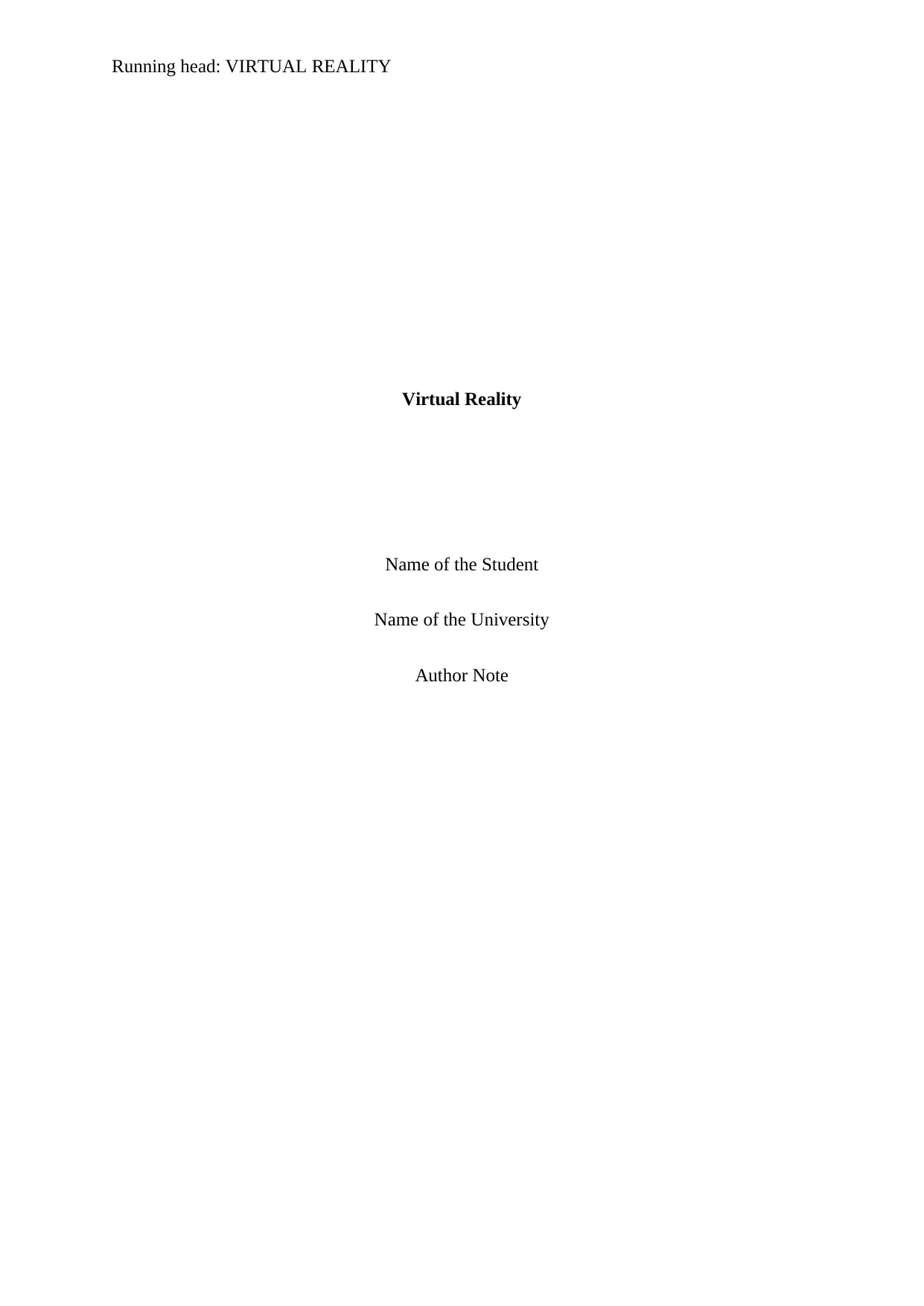
Running head: VIRTUAL REALITY
Virtual Reality
Name of the Student
Name of the University
Author Note
Virtual Reality
Name of the Student
Name of the University
Author Note
Paraphrase This Document
Need a fresh take? Get an instant paraphrase of this document with our AI Paraphraser
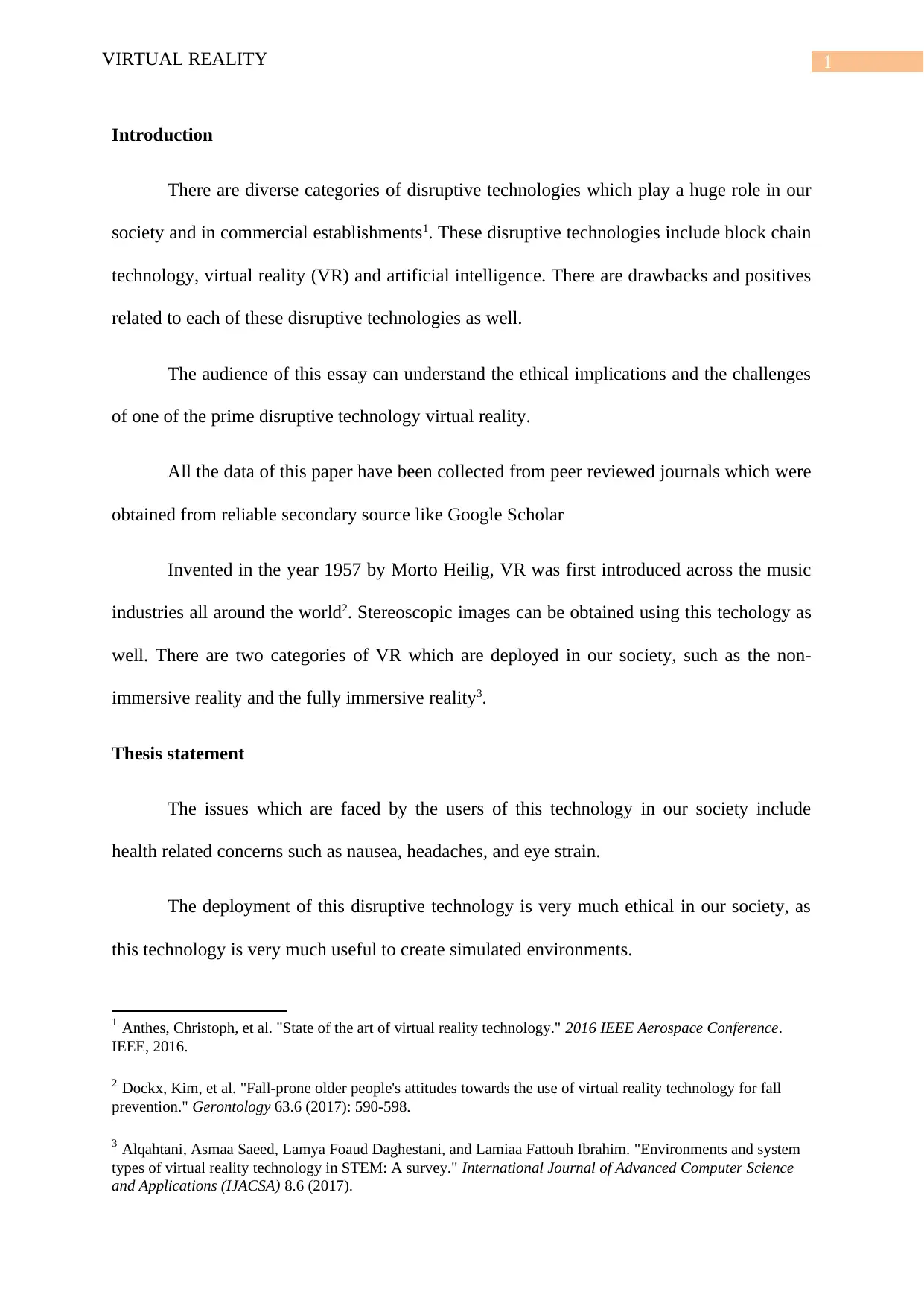
1VIRTUAL REALITY
Introduction
There are diverse categories of disruptive technologies which play a huge role in our
society and in commercial establishments1. These disruptive technologies include block chain
technology, virtual reality (VR) and artificial intelligence. There are drawbacks and positives
related to each of these disruptive technologies as well.
The audience of this essay can understand the ethical implications and the challenges
of one of the prime disruptive technology virtual reality.
All the data of this paper have been collected from peer reviewed journals which were
obtained from reliable secondary source like Google Scholar
Invented in the year 1957 by Morto Heilig, VR was first introduced across the music
industries all around the world2. Stereoscopic images can be obtained using this techology as
well. There are two categories of VR which are deployed in our society, such as the non-
immersive reality and the fully immersive reality3.
Thesis statement
The issues which are faced by the users of this technology in our society include
health related concerns such as nausea, headaches, and eye strain.
The deployment of this disruptive technology is very much ethical in our society, as
this technology is very much useful to create simulated environments.
1 Anthes, Christoph, et al. "State of the art of virtual reality technology." 2016 IEEE Aerospace Conference.
IEEE, 2016.
2 Dockx, Kim, et al. "Fall-prone older people's attitudes towards the use of virtual reality technology for fall
prevention." Gerontology 63.6 (2017): 590-598.
3 Alqahtani, Asmaa Saeed, Lamya Foaud Daghestani, and Lamiaa Fattouh Ibrahim. "Environments and system
types of virtual reality technology in STEM: A survey." International Journal of Advanced Computer Science
and Applications (IJACSA) 8.6 (2017).
Introduction
There are diverse categories of disruptive technologies which play a huge role in our
society and in commercial establishments1. These disruptive technologies include block chain
technology, virtual reality (VR) and artificial intelligence. There are drawbacks and positives
related to each of these disruptive technologies as well.
The audience of this essay can understand the ethical implications and the challenges
of one of the prime disruptive technology virtual reality.
All the data of this paper have been collected from peer reviewed journals which were
obtained from reliable secondary source like Google Scholar
Invented in the year 1957 by Morto Heilig, VR was first introduced across the music
industries all around the world2. Stereoscopic images can be obtained using this techology as
well. There are two categories of VR which are deployed in our society, such as the non-
immersive reality and the fully immersive reality3.
Thesis statement
The issues which are faced by the users of this technology in our society include
health related concerns such as nausea, headaches, and eye strain.
The deployment of this disruptive technology is very much ethical in our society, as
this technology is very much useful to create simulated environments.
1 Anthes, Christoph, et al. "State of the art of virtual reality technology." 2016 IEEE Aerospace Conference.
IEEE, 2016.
2 Dockx, Kim, et al. "Fall-prone older people's attitudes towards the use of virtual reality technology for fall
prevention." Gerontology 63.6 (2017): 590-598.
3 Alqahtani, Asmaa Saeed, Lamya Foaud Daghestani, and Lamiaa Fattouh Ibrahim. "Environments and system
types of virtual reality technology in STEM: A survey." International Journal of Advanced Computer Science
and Applications (IJACSA) 8.6 (2017).
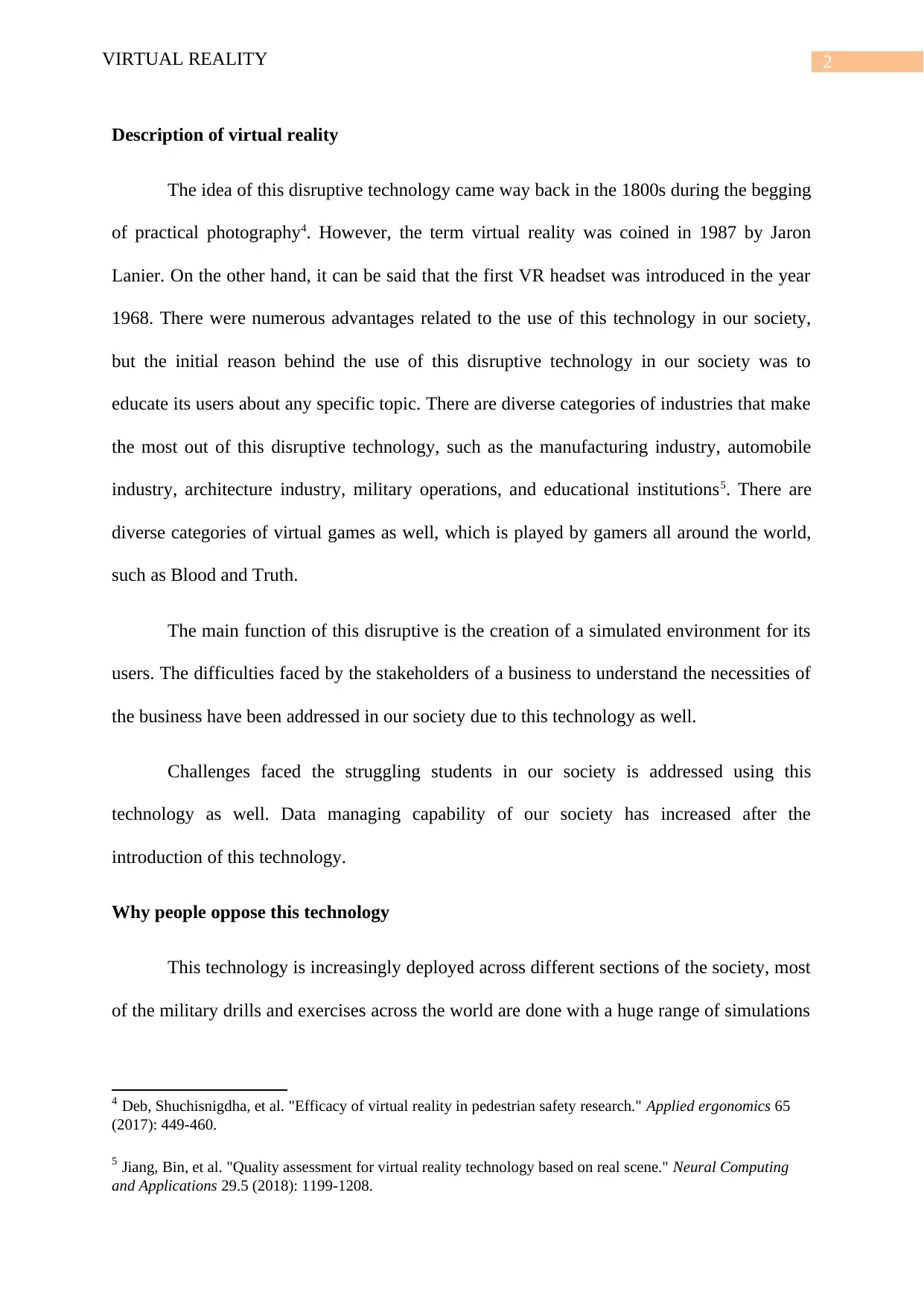
2VIRTUAL REALITY
Description of virtual reality
The idea of this disruptive technology came way back in the 1800s during the begging
of practical photography4. However, the term virtual reality was coined in 1987 by Jaron
Lanier. On the other hand, it can be said that the first VR headset was introduced in the year
1968. There were numerous advantages related to the use of this technology in our society,
but the initial reason behind the use of this disruptive technology in our society was to
educate its users about any specific topic. There are diverse categories of industries that make
the most out of this disruptive technology, such as the manufacturing industry, automobile
industry, architecture industry, military operations, and educational institutions5. There are
diverse categories of virtual games as well, which is played by gamers all around the world,
such as Blood and Truth.
The main function of this disruptive is the creation of a simulated environment for its
users. The difficulties faced by the stakeholders of a business to understand the necessities of
the business have been addressed in our society due to this technology as well.
Challenges faced the struggling students in our society is addressed using this
technology as well. Data managing capability of our society has increased after the
introduction of this technology.
Why people oppose this technology
This technology is increasingly deployed across different sections of the society, most
of the military drills and exercises across the world are done with a huge range of simulations
4 Deb, Shuchisnigdha, et al. "Efficacy of virtual reality in pedestrian safety research." Applied ergonomics 65
(2017): 449-460.
5 Jiang, Bin, et al. "Quality assessment for virtual reality technology based on real scene." Neural Computing
and Applications 29.5 (2018): 1199-1208.
Description of virtual reality
The idea of this disruptive technology came way back in the 1800s during the begging
of practical photography4. However, the term virtual reality was coined in 1987 by Jaron
Lanier. On the other hand, it can be said that the first VR headset was introduced in the year
1968. There were numerous advantages related to the use of this technology in our society,
but the initial reason behind the use of this disruptive technology in our society was to
educate its users about any specific topic. There are diverse categories of industries that make
the most out of this disruptive technology, such as the manufacturing industry, automobile
industry, architecture industry, military operations, and educational institutions5. There are
diverse categories of virtual games as well, which is played by gamers all around the world,
such as Blood and Truth.
The main function of this disruptive is the creation of a simulated environment for its
users. The difficulties faced by the stakeholders of a business to understand the necessities of
the business have been addressed in our society due to this technology as well.
Challenges faced the struggling students in our society is addressed using this
technology as well. Data managing capability of our society has increased after the
introduction of this technology.
Why people oppose this technology
This technology is increasingly deployed across different sections of the society, most
of the military drills and exercises across the world are done with a huge range of simulations
4 Deb, Shuchisnigdha, et al. "Efficacy of virtual reality in pedestrian safety research." Applied ergonomics 65
(2017): 449-460.
5 Jiang, Bin, et al. "Quality assessment for virtual reality technology based on real scene." Neural Computing
and Applications 29.5 (2018): 1199-1208.
⊘ This is a preview!⊘
Do you want full access?
Subscribe today to unlock all pages.

Trusted by 1+ million students worldwide
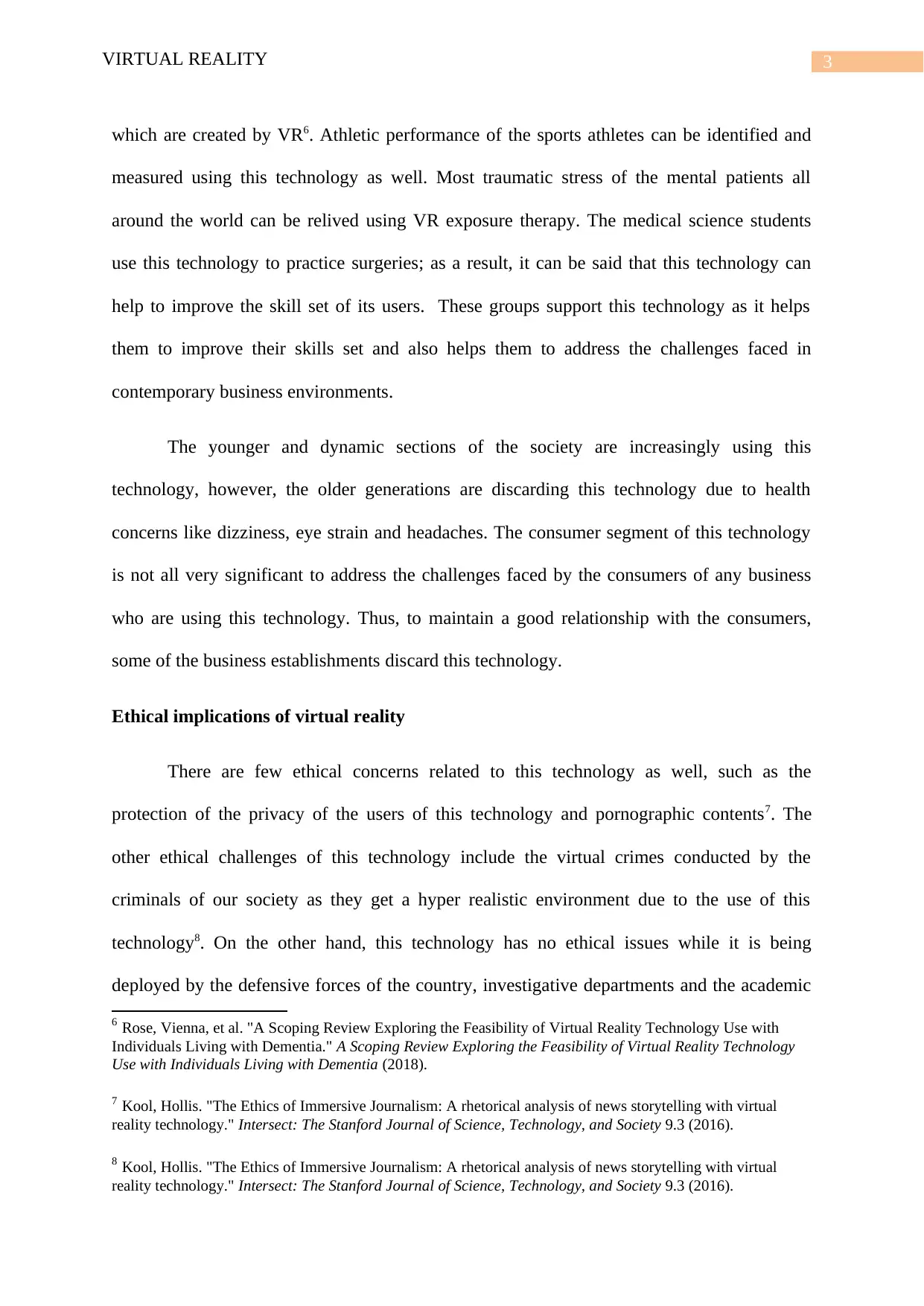
3VIRTUAL REALITY
which are created by VR6. Athletic performance of the sports athletes can be identified and
measured using this technology as well. Most traumatic stress of the mental patients all
around the world can be relived using VR exposure therapy. The medical science students
use this technology to practice surgeries; as a result, it can be said that this technology can
help to improve the skill set of its users. These groups support this technology as it helps
them to improve their skills set and also helps them to address the challenges faced in
contemporary business environments.
The younger and dynamic sections of the society are increasingly using this
technology, however, the older generations are discarding this technology due to health
concerns like dizziness, eye strain and headaches. The consumer segment of this technology
is not all very significant to address the challenges faced by the consumers of any business
who are using this technology. Thus, to maintain a good relationship with the consumers,
some of the business establishments discard this technology.
Ethical implications of virtual reality
There are few ethical concerns related to this technology as well, such as the
protection of the privacy of the users of this technology and pornographic contents7. The
other ethical challenges of this technology include the virtual crimes conducted by the
criminals of our society as they get a hyper realistic environment due to the use of this
technology8. On the other hand, this technology has no ethical issues while it is being
deployed by the defensive forces of the country, investigative departments and the academic
6 Rose, Vienna, et al. "A Scoping Review Exploring the Feasibility of Virtual Reality Technology Use with
Individuals Living with Dementia." A Scoping Review Exploring the Feasibility of Virtual Reality Technology
Use with Individuals Living with Dementia (2018).
7 Kool, Hollis. "The Ethics of Immersive Journalism: A rhetorical analysis of news storytelling with virtual
reality technology." Intersect: The Stanford Journal of Science, Technology, and Society 9.3 (2016).
8 Kool, Hollis. "The Ethics of Immersive Journalism: A rhetorical analysis of news storytelling with virtual
reality technology." Intersect: The Stanford Journal of Science, Technology, and Society 9.3 (2016).
which are created by VR6. Athletic performance of the sports athletes can be identified and
measured using this technology as well. Most traumatic stress of the mental patients all
around the world can be relived using VR exposure therapy. The medical science students
use this technology to practice surgeries; as a result, it can be said that this technology can
help to improve the skill set of its users. These groups support this technology as it helps
them to improve their skills set and also helps them to address the challenges faced in
contemporary business environments.
The younger and dynamic sections of the society are increasingly using this
technology, however, the older generations are discarding this technology due to health
concerns like dizziness, eye strain and headaches. The consumer segment of this technology
is not all very significant to address the challenges faced by the consumers of any business
who are using this technology. Thus, to maintain a good relationship with the consumers,
some of the business establishments discard this technology.
Ethical implications of virtual reality
There are few ethical concerns related to this technology as well, such as the
protection of the privacy of the users of this technology and pornographic contents7. The
other ethical challenges of this technology include the virtual crimes conducted by the
criminals of our society as they get a hyper realistic environment due to the use of this
technology8. On the other hand, this technology has no ethical issues while it is being
deployed by the defensive forces of the country, investigative departments and the academic
6 Rose, Vienna, et al. "A Scoping Review Exploring the Feasibility of Virtual Reality Technology Use with
Individuals Living with Dementia." A Scoping Review Exploring the Feasibility of Virtual Reality Technology
Use with Individuals Living with Dementia (2018).
7 Kool, Hollis. "The Ethics of Immersive Journalism: A rhetorical analysis of news storytelling with virtual
reality technology." Intersect: The Stanford Journal of Science, Technology, and Society 9.3 (2016).
8 Kool, Hollis. "The Ethics of Immersive Journalism: A rhetorical analysis of news storytelling with virtual
reality technology." Intersect: The Stanford Journal of Science, Technology, and Society 9.3 (2016).
Paraphrase This Document
Need a fresh take? Get an instant paraphrase of this document with our AI Paraphraser
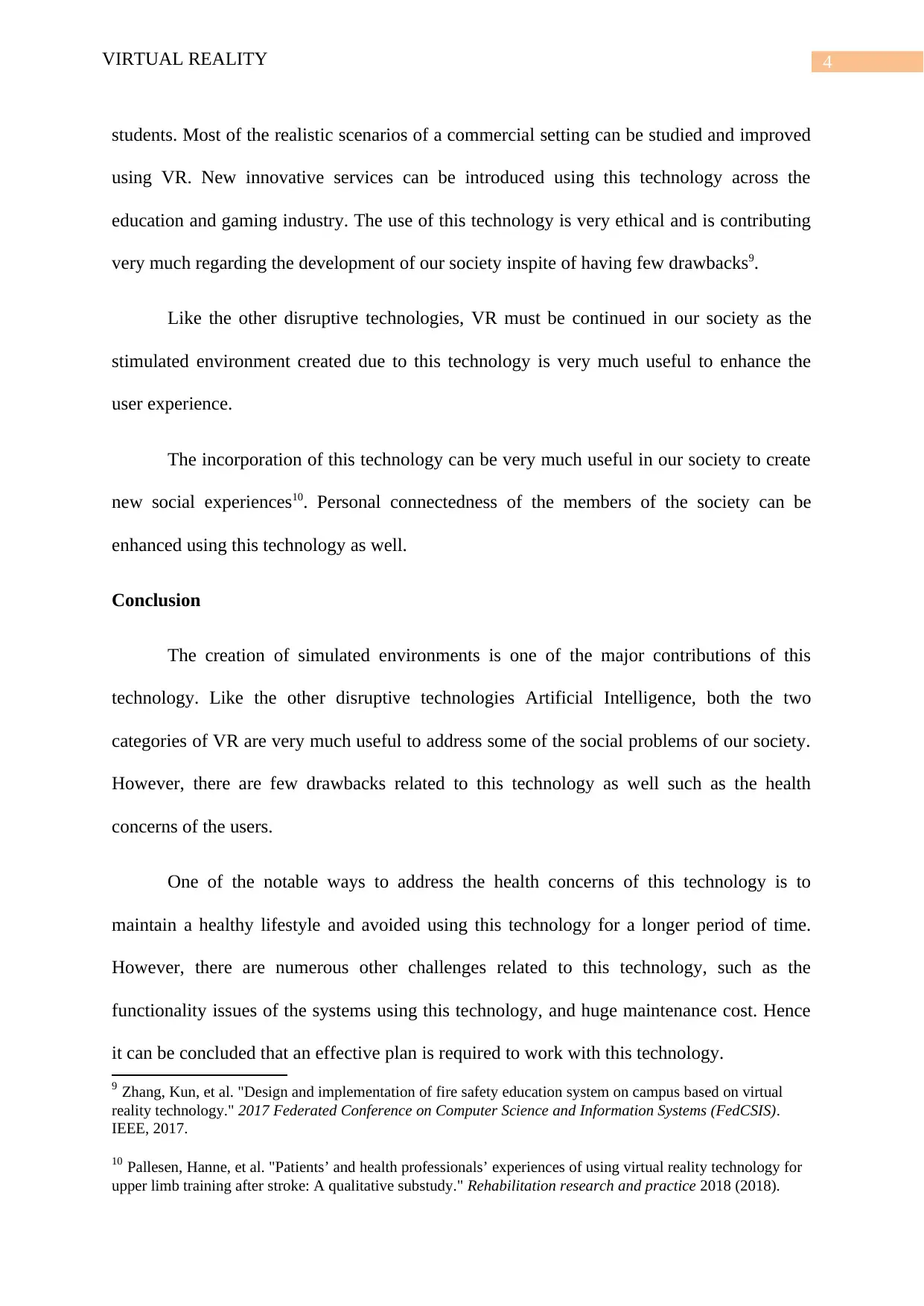
4VIRTUAL REALITY
students. Most of the realistic scenarios of a commercial setting can be studied and improved
using VR. New innovative services can be introduced using this technology across the
education and gaming industry. The use of this technology is very ethical and is contributing
very much regarding the development of our society inspite of having few drawbacks9.
Like the other disruptive technologies, VR must be continued in our society as the
stimulated environment created due to this technology is very much useful to enhance the
user experience.
The incorporation of this technology can be very much useful in our society to create
new social experiences10. Personal connectedness of the members of the society can be
enhanced using this technology as well.
Conclusion
The creation of simulated environments is one of the major contributions of this
technology. Like the other disruptive technologies Artificial Intelligence, both the two
categories of VR are very much useful to address some of the social problems of our society.
However, there are few drawbacks related to this technology as well such as the health
concerns of the users.
One of the notable ways to address the health concerns of this technology is to
maintain a healthy lifestyle and avoided using this technology for a longer period of time.
However, there are numerous other challenges related to this technology, such as the
functionality issues of the systems using this technology, and huge maintenance cost. Hence
it can be concluded that an effective plan is required to work with this technology.
9 Zhang, Kun, et al. "Design and implementation of fire safety education system on campus based on virtual
reality technology." 2017 Federated Conference on Computer Science and Information Systems (FedCSIS).
IEEE, 2017.
10 Pallesen, Hanne, et al. "Patients’ and health professionals’ experiences of using virtual reality technology for
upper limb training after stroke: A qualitative substudy." Rehabilitation research and practice 2018 (2018).
students. Most of the realistic scenarios of a commercial setting can be studied and improved
using VR. New innovative services can be introduced using this technology across the
education and gaming industry. The use of this technology is very ethical and is contributing
very much regarding the development of our society inspite of having few drawbacks9.
Like the other disruptive technologies, VR must be continued in our society as the
stimulated environment created due to this technology is very much useful to enhance the
user experience.
The incorporation of this technology can be very much useful in our society to create
new social experiences10. Personal connectedness of the members of the society can be
enhanced using this technology as well.
Conclusion
The creation of simulated environments is one of the major contributions of this
technology. Like the other disruptive technologies Artificial Intelligence, both the two
categories of VR are very much useful to address some of the social problems of our society.
However, there are few drawbacks related to this technology as well such as the health
concerns of the users.
One of the notable ways to address the health concerns of this technology is to
maintain a healthy lifestyle and avoided using this technology for a longer period of time.
However, there are numerous other challenges related to this technology, such as the
functionality issues of the systems using this technology, and huge maintenance cost. Hence
it can be concluded that an effective plan is required to work with this technology.
9 Zhang, Kun, et al. "Design and implementation of fire safety education system on campus based on virtual
reality technology." 2017 Federated Conference on Computer Science and Information Systems (FedCSIS).
IEEE, 2017.
10 Pallesen, Hanne, et al. "Patients’ and health professionals’ experiences of using virtual reality technology for
upper limb training after stroke: A qualitative substudy." Rehabilitation research and practice 2018 (2018).
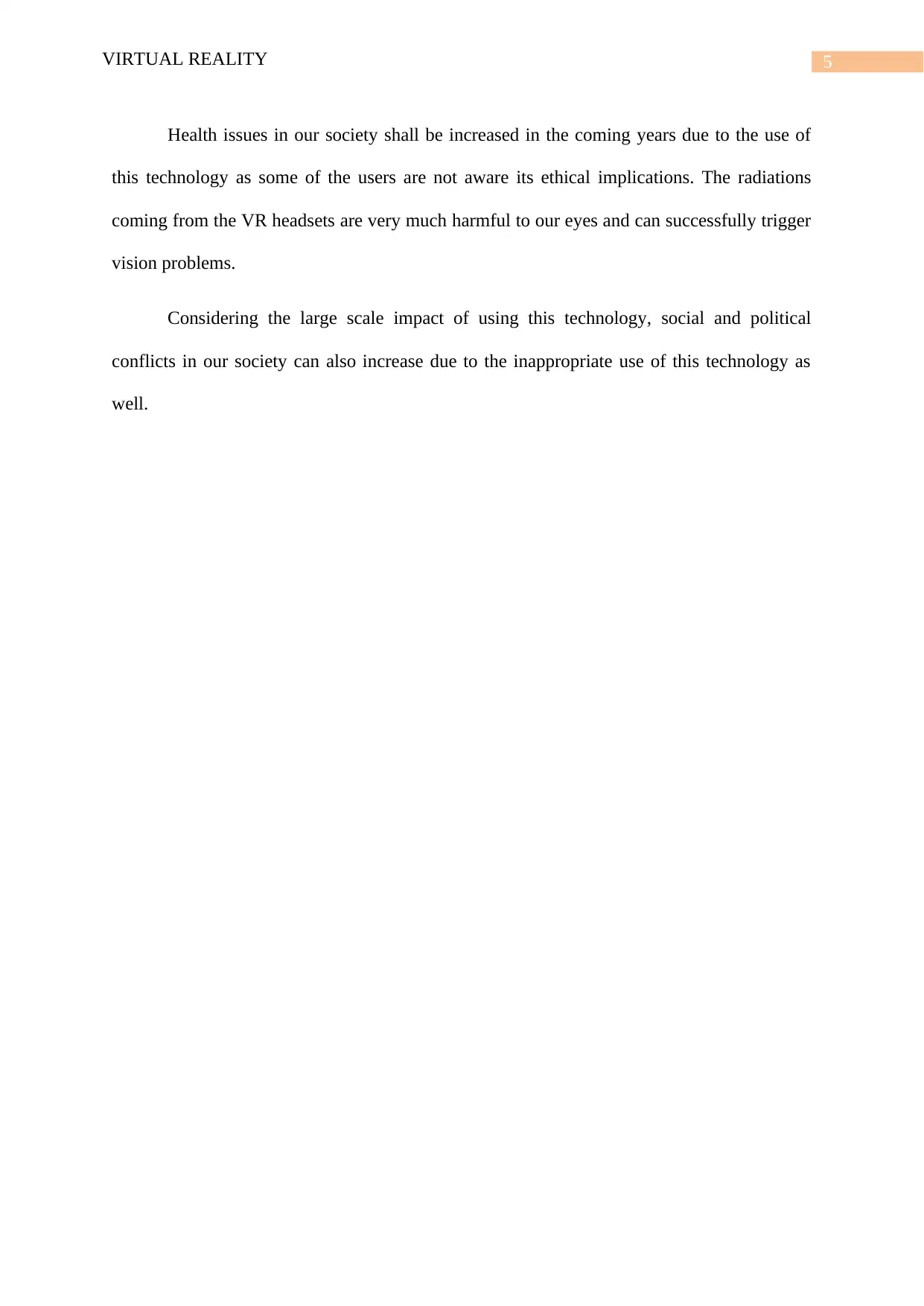
5VIRTUAL REALITY
Health issues in our society shall be increased in the coming years due to the use of
this technology as some of the users are not aware its ethical implications. The radiations
coming from the VR headsets are very much harmful to our eyes and can successfully trigger
vision problems.
Considering the large scale impact of using this technology, social and political
conflicts in our society can also increase due to the inappropriate use of this technology as
well.
Health issues in our society shall be increased in the coming years due to the use of
this technology as some of the users are not aware its ethical implications. The radiations
coming from the VR headsets are very much harmful to our eyes and can successfully trigger
vision problems.
Considering the large scale impact of using this technology, social and political
conflicts in our society can also increase due to the inappropriate use of this technology as
well.
⊘ This is a preview!⊘
Do you want full access?
Subscribe today to unlock all pages.

Trusted by 1+ million students worldwide
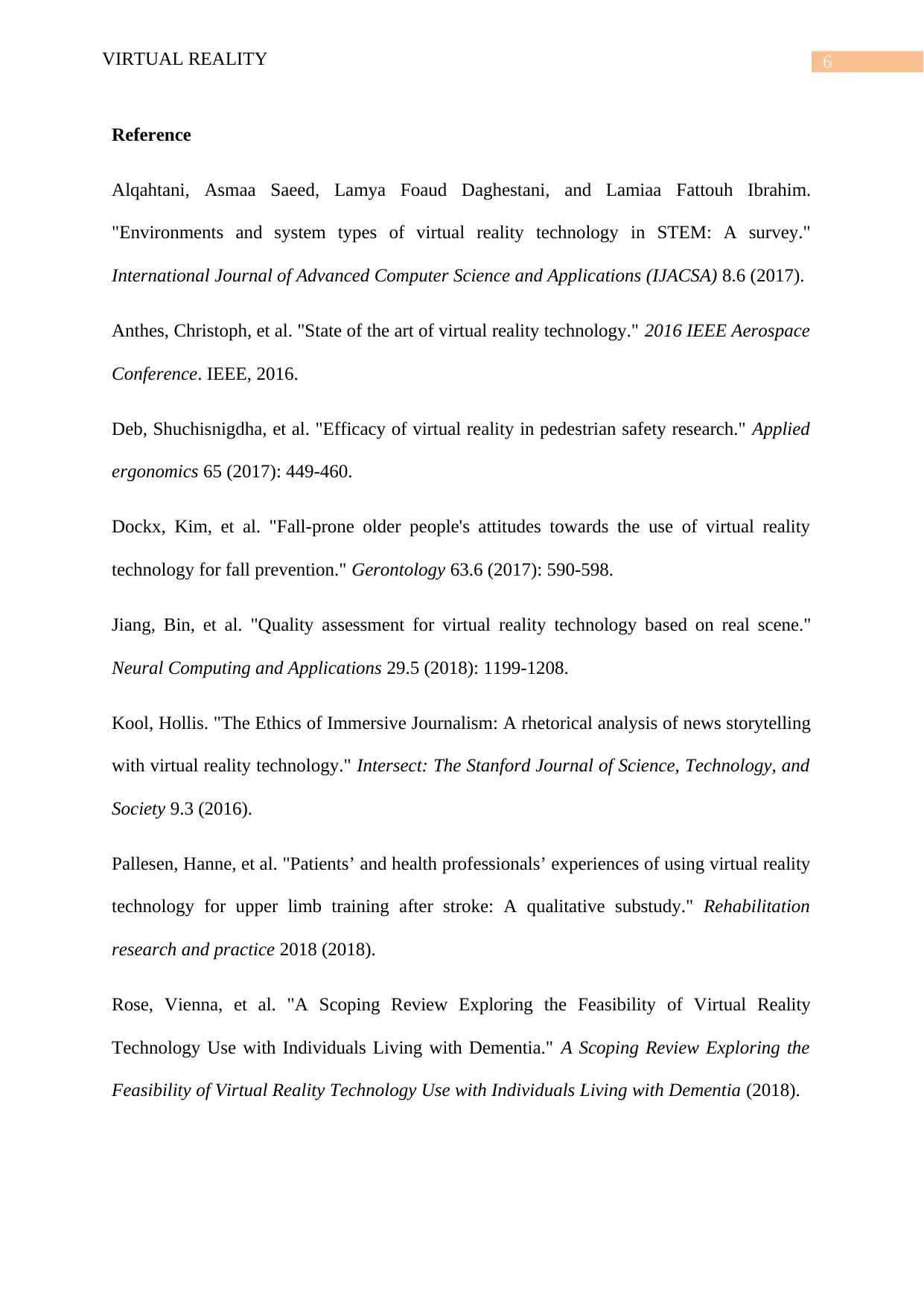
6VIRTUAL REALITY
Reference
Alqahtani, Asmaa Saeed, Lamya Foaud Daghestani, and Lamiaa Fattouh Ibrahim.
"Environments and system types of virtual reality technology in STEM: A survey."
International Journal of Advanced Computer Science and Applications (IJACSA) 8.6 (2017).
Anthes, Christoph, et al. "State of the art of virtual reality technology." 2016 IEEE Aerospace
Conference. IEEE, 2016.
Deb, Shuchisnigdha, et al. "Efficacy of virtual reality in pedestrian safety research." Applied
ergonomics 65 (2017): 449-460.
Dockx, Kim, et al. "Fall-prone older people's attitudes towards the use of virtual reality
technology for fall prevention." Gerontology 63.6 (2017): 590-598.
Jiang, Bin, et al. "Quality assessment for virtual reality technology based on real scene."
Neural Computing and Applications 29.5 (2018): 1199-1208.
Kool, Hollis. "The Ethics of Immersive Journalism: A rhetorical analysis of news storytelling
with virtual reality technology." Intersect: The Stanford Journal of Science, Technology, and
Society 9.3 (2016).
Pallesen, Hanne, et al. "Patients’ and health professionals’ experiences of using virtual reality
technology for upper limb training after stroke: A qualitative substudy." Rehabilitation
research and practice 2018 (2018).
Rose, Vienna, et al. "A Scoping Review Exploring the Feasibility of Virtual Reality
Technology Use with Individuals Living with Dementia." A Scoping Review Exploring the
Feasibility of Virtual Reality Technology Use with Individuals Living with Dementia (2018).
Reference
Alqahtani, Asmaa Saeed, Lamya Foaud Daghestani, and Lamiaa Fattouh Ibrahim.
"Environments and system types of virtual reality technology in STEM: A survey."
International Journal of Advanced Computer Science and Applications (IJACSA) 8.6 (2017).
Anthes, Christoph, et al. "State of the art of virtual reality technology." 2016 IEEE Aerospace
Conference. IEEE, 2016.
Deb, Shuchisnigdha, et al. "Efficacy of virtual reality in pedestrian safety research." Applied
ergonomics 65 (2017): 449-460.
Dockx, Kim, et al. "Fall-prone older people's attitudes towards the use of virtual reality
technology for fall prevention." Gerontology 63.6 (2017): 590-598.
Jiang, Bin, et al. "Quality assessment for virtual reality technology based on real scene."
Neural Computing and Applications 29.5 (2018): 1199-1208.
Kool, Hollis. "The Ethics of Immersive Journalism: A rhetorical analysis of news storytelling
with virtual reality technology." Intersect: The Stanford Journal of Science, Technology, and
Society 9.3 (2016).
Pallesen, Hanne, et al. "Patients’ and health professionals’ experiences of using virtual reality
technology for upper limb training after stroke: A qualitative substudy." Rehabilitation
research and practice 2018 (2018).
Rose, Vienna, et al. "A Scoping Review Exploring the Feasibility of Virtual Reality
Technology Use with Individuals Living with Dementia." A Scoping Review Exploring the
Feasibility of Virtual Reality Technology Use with Individuals Living with Dementia (2018).
Paraphrase This Document
Need a fresh take? Get an instant paraphrase of this document with our AI Paraphraser
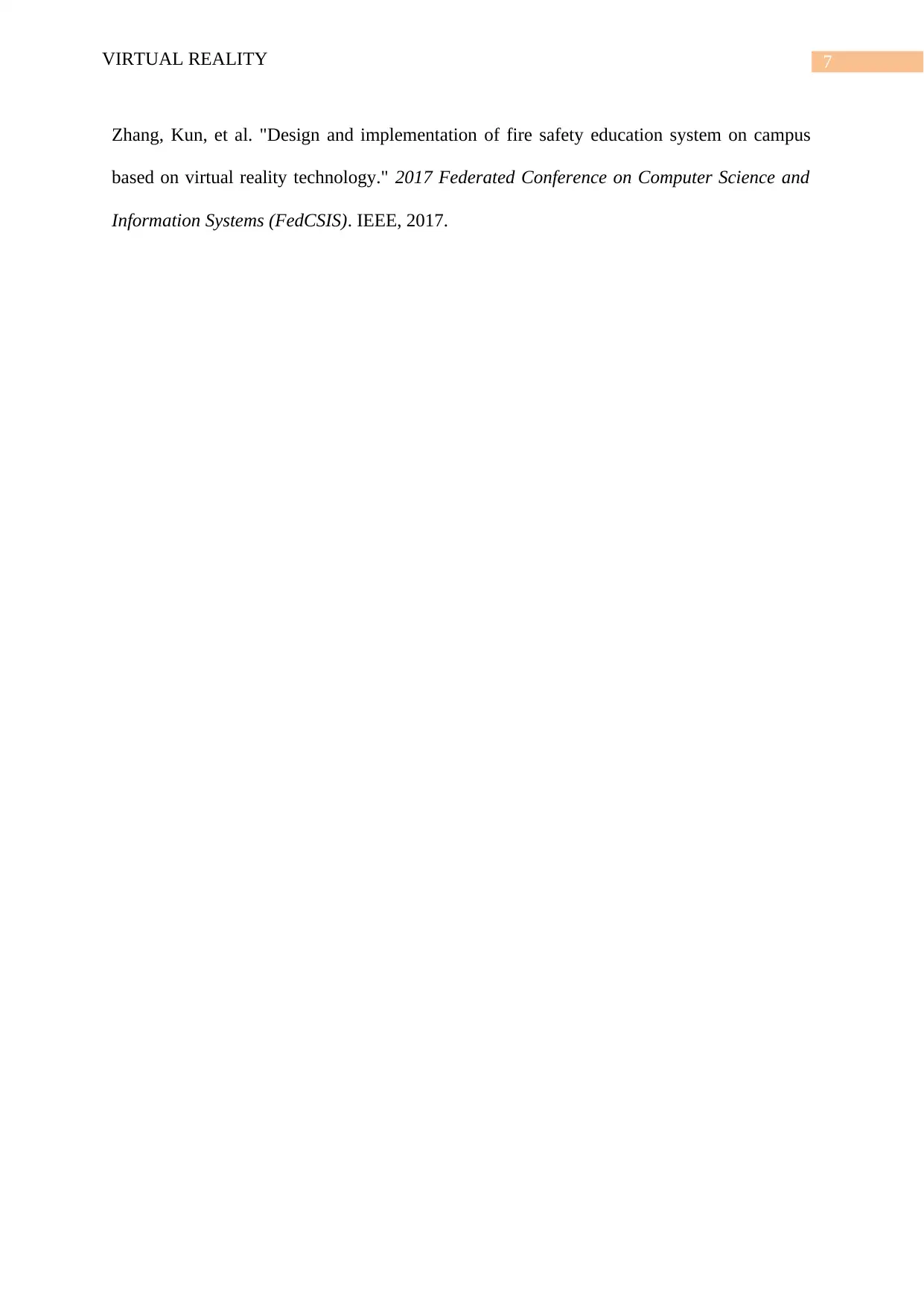
7VIRTUAL REALITY
Zhang, Kun, et al. "Design and implementation of fire safety education system on campus
based on virtual reality technology." 2017 Federated Conference on Computer Science and
Information Systems (FedCSIS). IEEE, 2017.
Zhang, Kun, et al. "Design and implementation of fire safety education system on campus
based on virtual reality technology." 2017 Federated Conference on Computer Science and
Information Systems (FedCSIS). IEEE, 2017.
1 out of 8
Related Documents
Your All-in-One AI-Powered Toolkit for Academic Success.
+13062052269
info@desklib.com
Available 24*7 on WhatsApp / Email
![[object Object]](/_next/static/media/star-bottom.7253800d.svg)
Unlock your academic potential
Copyright © 2020–2025 A2Z Services. All Rights Reserved. Developed and managed by ZUCOL.





